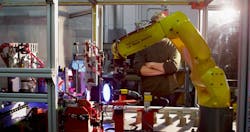Creating machines for a variety of projects certainly keeps work interesting at Compass Automation in Elgin, Illinois. The pair programming and agile engineering methodologies Compass uses to design the machines add innovation to the mix, as well. Considering the far-reaching industries Compass works with, such as automotive, medical, aerospace/defense, food production, consumer products and heavy industrial, good design is a must.
"Compass designs and builds custom automation for a variety of processes, such as assembly, inspection, deburring, machine tending and painting," notes Bill Angsten, executive vice president at Compass Automation. "Each industry has different requirements and expectations, but they all care about getting a successful machine built that is easy to operate and doesn’t become a maintenance nightmare."
Compass was started in 2009 by two friends, Bill Angsten and Patrick O’Rahilly, Jr., who went to the same high school, Marmion Academy, in Aurora, Illinois. A third classmate from Marmion, Brian Greviskes, joined them after the first year. The three of them, just 23 years old at the time, sought to build custom automation and help manufacturers in the United States compete globally.
Also read: Panel building advances OEM’s delivery times
"Compass grew, at first relying on industry-wide practices but, as the years went on, by trying very alternative methodologies to design and build machines," says Angsten. "Some of those divergent strategies included hiring mechanical engineers fresh out of MIT, writing their own software to manage operations, and using pair programming and agile engineering practices borrowed from the software development world."
Sean McRae, controls engineer at Compass Automation, monitors a robotic 100% part inspect and sort cell.
Source: Compass Automation
Compass currently has 30 employees and is engineering-heavy with seven mechanical engineers, eight controls engineers and a full build staff including electricians, machinists and machine builders capable of deploying automation across the United States.
Compass offers a full suite of post-installation support including PM, on-site and remote support and retrofits. “We offer our services for our machines and other automation that our customers have,” says Angsten. Support starts with properly debugging the machine on the Compass floor.
“Delivering a machine that works and has all of the troubleshooting documentation is our top priority," states Angsten. "We train their personnel on how to operationally run the machine and then how to maintain it properly. Beyond that, Compass has maintenance packages that allow us to remotely access the machines where almost all support items can be resolved. If they can’t be resolved remotely, Compass sends personnel to assist on-site. Remote networking, or using cell SIM cards if we can’t go through the customer’s network, allows us to more accurately and quickly assess a situation and drive toward a resolution."
Control options
Compass primarily utilizes PLCs for control. However, PC-based control, due to customer specifications or application requirements, are sometimes used.
"The majority of our machines utilize PLC-based controls," states Vlad Men, control engineering manager at Compass Automation. "We work with many of the popular controllers including Rockwell Automation/Allen Bradley, Siemens, Omron and Beckoff, among others. Compass also builds machines with PC-based controls." Compass utilizes reusable program templates and function blocks, or add-ons, to simplify project development and debug, says Men.
Networked hardware is becoming popular on Compass equipment. "Every machine has at least one kind of industrial network for I/O and intelligent devices such as servo drives, variable frequency drives (VFDs), smart cameras and barcode readers," notes Men. "EtherNet/IP and ProfiNet have been popular, and we recently had a very successful project with a mobile HMI using a wireless ProfiSafe connection."
For safety and depending on the system size, Compass uses a wide range of safety products—from hardwired safety relays to distributed safety systems using networked safety controllers and safety PLCs, comments Men. "Safety is application-specific, and our wide range of machine designs drives the diversity of our safety system design," he notes.
Innovation
"Compass has been very innovative when it comes to design methodology, and we deviate from the rest of the industry in doing so," states Angsten. "The unique strategies we employ are driven by the understanding that designs of custom equipment are inherently flawed." From the project onset, Compass pairs a mechanical engineer and a controls engineer to develop the machine.
The two work together, literally sharing a workstation, utilizing the pair programming methodology to design the machine. "This strategy allows us to have strong control logic input from the very onset," notes Angsten. "Immediate sharing of knowledge and working out problems with a partner has improved the quality of our designs."
The next thing Compass does is agile engineering: rapidly designing and prototyping individual stations of the machines, says Men. "We pull forward the most risky or complex elements of the system and perform iterative design and testing of the tooling—making sure that our designs actually work and are debugged early on,” he explains. “This strategy moves the most uncertain element of the custom machine build up to the very front of the project."
The industry is evolving rapidly, states Angsten. “Cameras are getting smarter, mechanisms are getting faster and more accurate, automation is becoming more flexible, but two specific elements of our industry might have the biggest impact: collaborative and self-learning robots,” he says. “If the price point continues to drop, and the robustness improves, collaborative robots will become the rule instead of the exception. They don’t require guarding, which means less floor-space requirement and they can fit more easily into the natural work environment. Then, if those same robots become easier to program because they are self-learning, they become easier to justify because they take less time to program and become a lot more flexible."
Tim Wilczynski, mechanical engineer at Compass Automation, checks tooling on a robotic assembly equipment.
Source: Compass Automation







